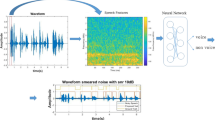Abstract
This paper is involved with robustness for voice activity detection (VAD) approaches. The proposed approaches employ a few short term speech/non-speech discriminating characteristics to obtain a satisfactory performance in different environments. This paper mainly focuses on the performance improvement of recently proposed approaches which utilize spectral peak valley difference (SPVD) as a silence detection feature. The primary problem of this paper is to use a set of features with SPVD to improve the VAD robustness. The proposed approaches use deep learning approaches which are DNN, RNN and CNN, in order to analyze the robust VAD systems of the noise. The experiments show that the proposed deep learning approaches are compared with some other VAD techniques for better demonstration of its results in various noise and different SNRs circumstances. Applying the proposed approaches, the average of VAD performances are improved respectively to 89.72%, 95.01%, 92.05% for 5 diverse noise types. The result of LSTM performance is even 10.29% over than the method based on DNN and also 7.96% over than the CNN.
Access this chapter
Tax calculation will be finalised at checkout
Purchases are for personal use only
Similar content being viewed by others
References
Ishizuka K, Nakatani T, Fujimoto M, Miyazaki N (2010) Noise robust voice activity detection based on periodic to aperiodic component ratio ☆. Speech Commun 52(1):41–60
Shafiee S, Almasganj F, Vazirnezhad B, Jafari A (2010) A two-stage speech activity detection system considering fractal aspects of prosody. Pattern Recogn Lett 31(9):936–948
Moattar MH, Homayounpour MM (2010) A simple but efficient real-time voice activity detection algorithm. In: 2009 European signal processing conference. IEEE
Yoo IC, Yook D (2009) Robust voice activity detection using the spectral peaks of vowel sounds. ETRI J 31(4):451–453
Moattar MH, Homayounpour MM, Kalantari NK (2010) A new approach for robust realtime voice activity detection using spectral pattern, 23(3):4478–4481
Mateju L, Cerva P Zdansky J (2016) Study on the use of deep neural networks for speech activity detection in broadcast recordings. In: International conference on signal processing and multimedia applications
Zhang XL, Wu J (2013) Deep belief networks based voice activity detection. IEEE Trans Audio Speech Lang Process 21(4):697–710
Eyben F, Weninger F, Squartini S, Schuller B (2013) Real-life voice activity detection with LSTM recurrent neural networks and an application to hollywood movies. In: ICASSP, vol 32, pp 483–487
Thomas S, Ganapathy S, Saon G, Soltau H (2014) Analyzing convolutional neural networks for speech activity detection in mismatched acoustic conditions. In: ICASSP 2014 - 2014 IEEE international conference on acoustics, speech and signal processing, pp 2519–2523
Thomas S, Saon G, Segbroeck MV, Narayanan SS (2013) Improvements to the IBM speech activity detection system for the DARPA RATS program. In: IEEE international conference on acoustics. The Boreal Forest Society, pp 114–116
Lee B, Hasegawa-Johnson M (2008) Minimum mean-squared error a posteriori estimation of high variance vehicular noise
Acknowledgements
This work was supported in part by the Youth Fund of the Sichuan Provincial Education Department under Grant 18ZB0467.
Author information
Authors and Affiliations
Corresponding author
Editor information
Editors and Affiliations
Rights and permissions
Copyright information
© 2020 Springer Nature Switzerland AG
About this paper
Cite this paper
Wang, M. et al. (2020). Deep Learning Approaches for Voice Activity Detection. In: Xu, Z., Choo, KK., Dehghantanha, A., Parizi, R., Hammoudeh, M. (eds) Cyber Security Intelligence and Analytics. CSIA 2019. Advances in Intelligent Systems and Computing, vol 928. Springer, Cham. https://doi.org/10.1007/978-3-030-15235-2_110
Download citation
DOI: https://doi.org/10.1007/978-3-030-15235-2_110
Published:
Publisher Name: Springer, Cham
Print ISBN: 978-3-030-15234-5
Online ISBN: 978-3-030-15235-2
eBook Packages: Intelligent Technologies and RoboticsIntelligent Technologies and Robotics (R0)




